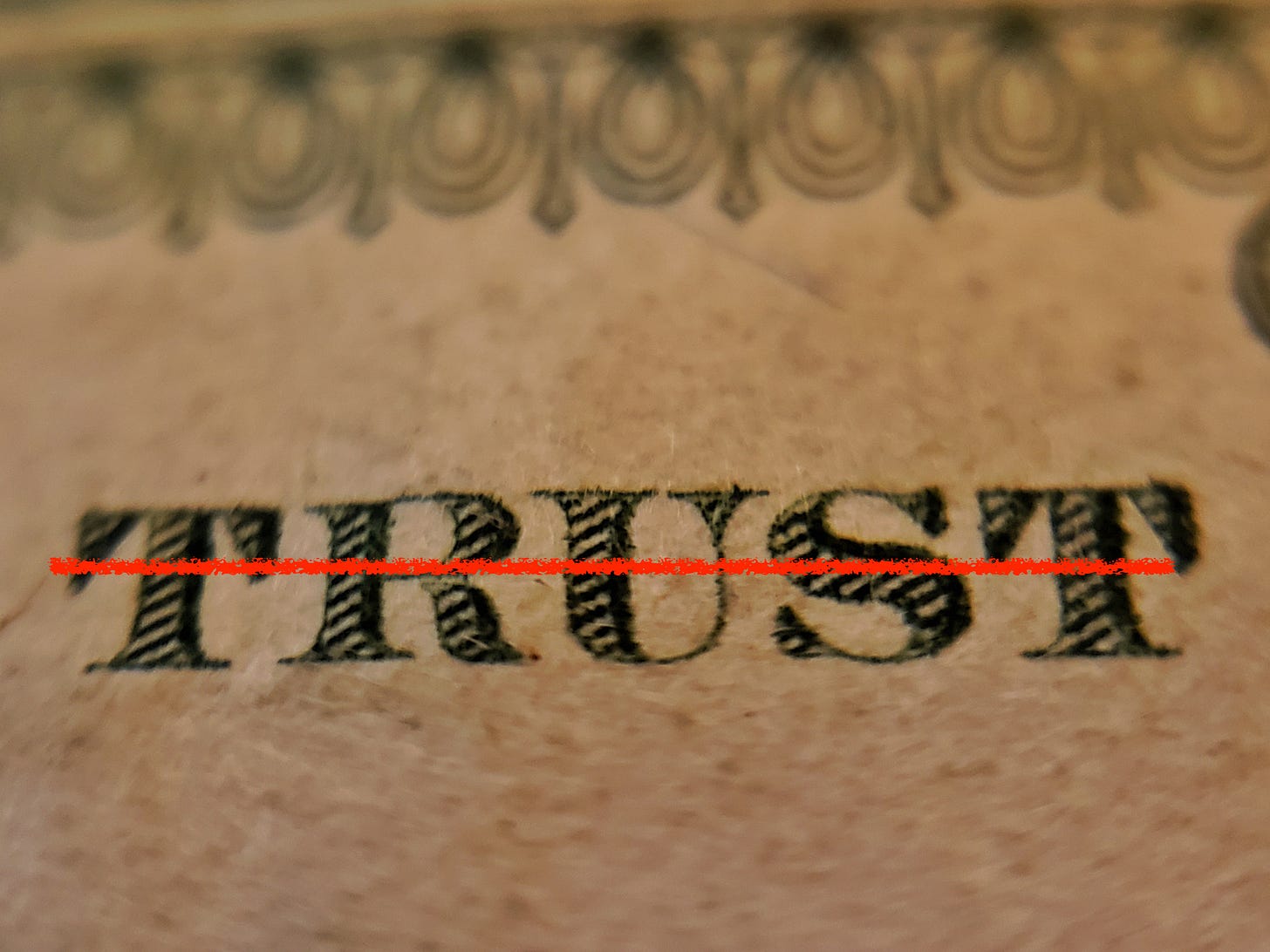
If you don’t have enough time to read all the way through this edition of the newsletter, please skip ahead to the “Back to Basics — Entering the (Mostly) Trustless State” section for important information regarding self-custody of your Bitcoin and other digital assets.
This FTX situation has been hard to swallow.
I’ve been hearing stories from people who know people who have lost money as a result of the fraud that FTX’s former CEO Sam Bankman-Fried (SBF) and his partners Caroline Ellison, Sam Trabucco and others perpetrated on so many. My heart is broken and my stomach is a mess.
Plus, I’ve been indirectly affected by it — which has made me angry and frustrated. (I’ll come back to that further down.)
What’s also been gut-wrenching has been watching the left-leaning mainstream media give SBF and co. a pass.






That last tweet — from Snoop Dogg (Cozomo de’ Medici is a pseudonym he uses) — brings up an important point.
SBF was the second largest donor to Joe Biden’s campaign in 2020.
And he donated $40 million to Democratic candidates in the 2022 midterms.

Oddly enough, I experienced the sway of his political donations firsthand in this previous election cycle.
My friend’s sister ran as an AOC-endorsed progressive in the Democratic primary, and I attended one of her events to offer her some counsel on her messaging regarding Bitcoin/crypto at my friend’s request.
She ended up losing that primary to a Democratic candidate who joined the race last minute and stole her talking points — after she had campaigned on these talking points for over a year. This candidate was funded by SBF.
So, not only does SBF like to steal things, but he apparently likes to support people who steal things, as well.
We’ll have to wait and see if any of the Democrats who took money from SBF have the decency to give whatever is left of those donations back to FTX in efforts to make the platform’s former clients whole in the bankruptcy proceedings.
I wrote that last sentence just to be silly.
Politicians giving money back to people… LOL.
But I digress.
In this edition of the newsletter, I want to talk about how you can avoid becoming a direct and/or indirect victim of someone like SBF.
I’ll start with some context/a warning.
Issues with Gemini Earn/Grow
In the “Investing without Principals” edition of the newsletter I published two weeks ago, I discussed using Gemini’s Earn/Grow option to invest.
While I included a disclaimer that stated that there were risks involved with using it, I regret mentioning it now that Gemini has stated that redemptions from its Earn/Grow program may take longer than 5 days, which the amount of time they usually take as per Gemini’s service-level agreement (SLA).
I discussed what’s happening in the video below:
You can also read the statement from Gemini to learn more.
Gemini’s delaying redemptions isn’t a good sign, though.
As we’ve seen with Celsius, BlockFi and Voyager — other institutions that offered services similar to Gemini Earn/Grow — when redemptions or withdrawals are halted, it usually means that there is an issue with liquidity — or that these platforms don’t have the money to pay out.
I had some money (not a ton, thank goodness) in Gemini Earn/Grow, and I’ve redeemed it in hopes that the redemption will just be a bit delayed and not permanently delayed.
The digital assets that I had in Gemini Earn/Grow was actually the last bit of my investment in the space that I didn’t hold in my own custody — and I obviously regret not holding these assets in my own custody now.
I learned the hard way the risk involved with lending my digital assets to efforts to earn a yield.
It’s hard to admit that I’m still learning a lesson like this, but it’s worse for me to not acknowledge it.
So, IMHO, it’s best not to use Gemini Earn/Grow or any crypto lending product — even if they have a good reputation — if you are trying to be as safe as possible with your investment.
While I don’t make recommendations or give financial advice in this newsletter, I will say that it’s probably a very good idea to redeem your money from Gemini Earn/Grow and to move whatever that asset is into self-custody (I’ll get to what that means in a moment.)
Now, that rates are a bit higher for traditional savings accounts, you might want to consider not using stablecoins to earn a yield, and instead regular dollars in a high-interest savings account through a bank like Ally, which is currently offering 2.75% APY.
Anyway, I share this not only as a warning or update about Gemini Earn/Grow, but to illustrate that I placed my trust in Gemini, and now that trust is broken.
That in and of itself is fine, as sometimes this happens, but Bitcoin was created to do away with having to trust a counterparty, which brings me to the next section.

Back to Basics — Entering the (Mostly) Trustless State
Bitcoin was built to eliminate trust in third-party financial institutions, as it enabled peer-to-peer transactions.
To fulfill this promise of Bitcoin, you have to take the private keys for your BTC off of crypto exchanges and move them into a non-custodial wallet.
(If I look like I got hit by a truck in this video, it’s because it’s been a rough two weeks in the wake of the FTX implosion and sleep is no longer my friend. Also, I’m Italian-American — howyadoinz — and I’m getting to that age where the dark circles around the eyes are more of a thing.)
What’s a non-custodial wallet? Good question.
Here’s a piece I wrote for Finder this week in which I discuss what they are and which are the best on the market: “12 best non-custodial wallets”
The concept of a non-custodial wallet is very new to most people, so don’t stress it if you don’t understand what they are just yet.
However, don’t remain ignorant to what they are if you’ve chosen to invest in bitcoin (BTC) or other digital assets. Learning to use a non-custodial wallet is part of learning to be a responsible investor in this space.
Most of us are used to looking at either our bank or brokerage balance on our computer screen through of a financial institution.
What I’d bet most people don’t think about when they look at those balances is that all of the assets that appear on your screen are just IOUs.
In the case of a bank account, we can make those IOUs real by withdrawing cash.
As far as our investments in stocks, equities, ETFs, etc., the records of those now primarily reside on closed digital databases. We trust institutions like Fidelity or Charles Schwab to keep proper records our digital claims to traditional assets.
With Bitcoin and other digital assets, when we look at our balances via a crypto exchange like Coinbase, Binance or Gemini, those assets are just IOUs, too.
You are an unsecured creditor to these exchanges.
Let me explain what this fancy term “unsecured creditor” means. It means that in the event that the exchange that holds the private keys to your crypto assets becomes insolvent, you don’t get your assets back from them.
This is what the many, many people who were unsecured creditors to FTX are now experiencing.
With digital assets, risk is multidimensional.
You not only have to deal with the volatility of the prices of these assets, but you have to learn how to custody them yourself.

Again, please read “12 best…” article I linked to above to learn more, and know that I’m working with Finder to produce some videos on how to transfer your private keys from a crypto exchange to a non-custodial wallet. I’ll share said video once it’s been published.
If your digital assets are in the custody of a crypto exchange and you don’t want to spend money buying a non-custodial hardware wallet, I recommend using a desktop wallet like Exodus or Atomic to store the private keys to your assets for now.
If you have a sizable amount of money invested in the space and don’t want to leave the private keys to those assets in the custody of a centralized exchange, then I would recommend buying a Ledger Nano S Plus (Please read this piece in full before you purchase this device. I wrote the piece and included important warnings in it), what I consider to be the best hardware wallet on the market for the money.
When you use a hardware wallet, you’re still trusting the maker of the wallet to some degree, but I’ve never read a report of someone losing the private keys to their digital assets as a result of a hardware wallet getting hacked.
You also have to trust yourself to be the custodian of your funds when you use any non-custodial wallet.
If this all sounds confusing to you, and it makes you want to give up on investing in this world then maybe investing in this world isn’t for you — and that is both okay and completely understandable.
I’m not here to convince you to invest in this space. I’m simply trying to show you how to do so as safely as possible.
I write this newsletter not to be an evangelist, but to be a counter to the mainstream media’s perception of Bitcoin and some assets in the broader digital asset space.
About 98-99% of the crypto space is BS. But there’s real value in the 1-2% that is legit.
So, if there’s anything to take away from this edition of the newsletter, it’s that storing the private keys to your Bitcoin (or other digital assets — though, there is a major difference between bitcoin and all other digital assets, which I will touch on in the next edition of the newsletter) in a non-custodial hardware wallet like a Ledger Nano S Plus is the safest way I know of to truly own and secure the asset.
For more on other benefits regarding the self-custody of your digital assets, please read the following piece I wrote for Nasdaq on behalf of Finder:
“Once More for the People in the Back: Get Your Digital Assets off Centralized Exchanges”
Also, here’s a great tweet thread on why it benefits you to get your Bitcoin off of exchanges:

Last Thought for Today: The SEC on the Failures of the SEC
I wanted to highlight a point I made in the previous edition of the newsletter entitled: “Meet the Guilty Parties: Wall Street Traders and Government Regulators.”
I mentioned that the SEC has regulated by arbitrary enforcement of unclear and/or nonexistent regulations and hasn’t provided a proper framework for crypto companies that want to set up shop in the US.
In this edition of the newsletter, I wanted to let you know that a high-ranking member of the SEC agrees with me.

If only a sensible person like SEC Commissioner Hester Peirce were at the helm at the SEC.
For now, we remain stuck with Gary Gensler, someone who I do not believe has the best intentions of American investors at heart when it comes to Bitcoin and other digital assets.

I hope everyone out there is weathering this storm okay. Some say that the contagion from this fallout will spread further, and I tend to agree.
As I’ve said since the war in Ukraine broke out, “I don’t know” what will happen from here and can only repeat that it’s best not to invest more than you can afford to lose, especially in such uncertain times.
Again, though, nothing in this newsletter is financial advice. I write it for educational purposes only.
Big hug to everyone.
Best,
Frank
Twitter: @frankcorva
Currently reading: “White Boy” by Arthur Hayes (one of the best takes I’ve read on SBF thus far)





